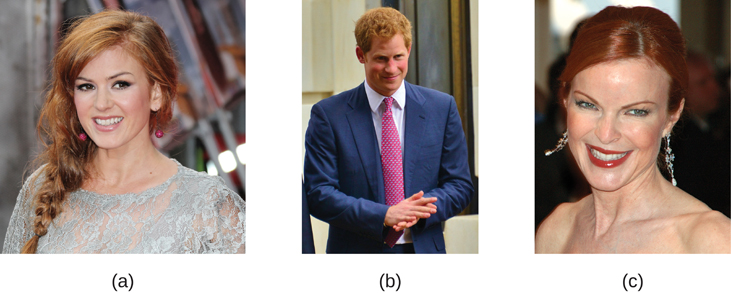Chapter 18. Psychological Disorders
What are Psychological Disorders?
Leanne Stevens; Jennifer Stamp; Kevin LeBlanc (editors - original chapter); and Jessica Motherwell McFarlane (editor - adapted chapter)
Approximate reading time: 16 minutes
Content disclosure: Fear of spiders will be discussed in one of the examples below.
A psychological disorder is a condition characterised by abnormal thoughts, feelings, and behaviours. Psychopathology is the study of psychological disorders, including their symptoms, etiology (the cause or reasons behind something), and treatment. The term psychopathology can also refer to the display or showing of something, like symptoms of a disease or a psychological disorder. Although consensus (agreement among a group of people) can be difficult, it is extremely important for mental health professionals to agree on what kinds of thoughts, feelings, and behaviours are truly abnormal in the sense that they genuinely indicate the presence of psychopathology.
Certain patterns of behaviour and inner experience can easily be labeled as abnormal and clearly signify some kind of psychological disturbance. The person who washes their hands 40 times per day and the person who claims to hear the voices of demons exhibit behaviours and inner experiences that most would regard as abnormal — beliefs and behaviours that suggest the existence of a psychological disorder. But consider the nervousness a young person feels when talking to an attractive person or the loneliness and longing for home a first-year student experiences during their first semester of college; these feelings may not be regularly present, but they fall in the range of normal.
So, what kinds of thoughts, feelings, and behaviours represent a true psychological disorder? Psychologists try to tell the difference between mental health problems and feelings or actions that are just based on a situation, unique to a person, or not usual. They want to make sure that when they say someone has a mental health issue, it’s not just because of something that happened once or because someone acts in a way that’s a bit different from most people.
Definition of a Psychological Disorder
Perhaps the simplest approach to conceptualising psychological disorders is to label behaviours, thoughts, and inner experiences that are atypical (unusual or not what’s normally expected), distressful, dysfunctional (not working properly or normally), and sometimes even dangerous, as signs of a disorder. For example, if you ask a classmate for a date and you are rejected, you probably would feel a little dejected. Such feelings would be normal. If you felt extremely depressed — so much so that you lost interest in activities, had difficulty eating or sleeping, felt utterly worthless, and contemplated suicide — your feelings would be atypical, would deviate from the norm, and could signify the presence of a psychological disorder. Just because something is atypical, however, does not necessarily mean it is disordered. More criteria are required for a psychological disorder.
For example, only about 2-6% of people in Canada have red hair, so red hair is considered an atypical characteristic (Figure PD.2), but it is not considered disordered; it’s just unusual. And it is less unusual in Scotland, where approximately 13% of the population has red hair (“DNA Project Aims,” 2012). As you will learn, some disorders, although not exactly typical, are far from atypical, and the rates in which they appear in the population are surprisingly high.

If we can agree that merely being atypical is an insufficient criterion for a having a psychological disorder, is it reasonable to consider behaviour or inner experiences that differ widely from expected cultural values or expectations disordered? Using this criterion, a person who walks around a subway platform wearing a heavy winter coat in July while screaming obscenities at strangers may be considered to exhibit symptoms of a psychological disorder. Their actions and clothes violate socially accepted rules governing appropriate dress and behaviour; these characteristics are atypical.
Cultural Expectations
Violating cultural expectations is not, in and of itself, a satisfactory means of identifying the presence of a psychological disorder. Since behaviour varies from one culture to another, what may be expected and considered appropriate in one culture may not be viewed as such in other cultures. For example, returning a stranger’s smile is expected in the United States because a pervasive social norm dictates that we reciprocate friendly gestures. This pressure to smile is even greater for female-presenting people. A person who refuses to acknowledge such gestures might be considered disrespectful, socially awkward — perhaps even disordered — for violating this expectation. However, such expectations are not universally shared.
Cultural expectations in Japan involve showing reserve, restraint, and a concern for maintaining privacy around strangers. Japanese people are generally unresponsive to smiles from strangers (Patterson et al., 2007). Eye contact is another example. In the United States and Europe, eye contact with others typically signifies honesty and attention. However, most Latin-American, Asian, and African cultures interpret direct eye contact as rude, confrontational, and aggressive (Pazain, 2010). Thus, someone who makes eye contact with you could be considered appropriate and respectful or brazen and offensive, depending on your culture (Figure PD.3).

In some cultures and societies, hallucinations (seeing, hearing or feeling things that aren’t really there) are a violation of cultural expectations; a person who reports such inner experiences is readily labeled as psychologically disordered. In other cultures and societies, visions that, for example, pertain to future events may be regarded as normal experiences that are positively valued (Bourguignon, 1970).
Finally, it is important to recognise that cultural norms change over time. What might be considered typical in a society at one time may no longer be viewed this way later, e.g., fashion trends from one era may elicit quizzical looks decades later; imagine how the lace collars, broad-brimmed hats, and slashed sleeves — high-fashion in the 1600s (Figure PD.4) would go over on your campus today.

The Myth of Mental Illness
In the 1950s and 1960s, some people started to question the idea of mental illness. They thought that calling something a “mental illness” was just a way to disagree with behaviours that society didn’t like (Wakefield, 1992). Thomas Szasz, a well-known psychiatrist, strongly believed in this idea. He said that society and doctors made up the idea of mental illness to control or criticise people who acted differently from what was normally accepted. Szasz wrote that what we often call symptoms of mental illness are actually just challenges people face in life (Szasz, 1960).
In his book from 1961, The Myth of Mental Illness: Foundations of a Theory of Personal Conduct, Szasz shared his negative views on mental illness and psychiatry (Oliver, 2006). He believed that real sickness could only be something discoverable through medical tests, like infections or organ problems. Since mental illness can’t always be seen this way, he argued that psychological disorders aren’t real illnesses (Szasz, 1961/2010).
Despite Szasz’s controversial opinions, it’s hard to ignore the real struggles that people with mental health issues face, including their painful thoughts, feelings, and the difficult behaviours they might exhibit.
Even though Szasz’s ideas were debated, they did change how people think about mental health. Now, many refer to mental health issues as “problems” instead of illnesses, which reflects Szasz’s way of thinking (Buchanan-Barker & Barker, 2009). Szasz was also one of the first psychiatrists to say that being gay shouldn’t be considered a mental illness. This helped to improve the rights and acceptance of gay and lesbian people (Barker, 2010). His ideas also led to changes in laws that give people in psychiatric care more control over their lives (Buchanan-Barker & Barker, 2009).
Harmful Dysfunction
If none of the criteria discussed so far is adequate by itself to define the presence of a psychological disorder, how can a disorder be conceptualised? Many efforts have been made to identify the specific dimensions of psychological disorders, yet none is entirely satisfactory. No universal definition of psychological disorder exists that can apply to all situations in which a disorder is thought to be present (Zachar & Kendler, 2007). However, one of the more influential conceptualisations was proposed by Wakefield (1992), who defined psychological disorder as a harmful dysfunction. Wakefield argued that natural internal mechanisms — that is, psychological processes honed by evolution, such as cognition, perception, and learning — have important functions, such as enabling us to experience the world the way others do and to engage in rational thought, problem solving, and communication. For example, learning allows us to associate a fear with a potential danger in such a way that the intensity of fear is roughly equal to the degree of actual danger. Dysfunction occurs when an internal mechanism breaks down and can no longer perform its normal function. But the presence of a dysfunction by itself does not determine a disorder. The dysfunction must be harmful in that it leads to negative consequences for the individual or for others, as judged by the standards of the individual’s culture. The harm may include significant internal anguish (e.g., high levels of anxiety or depression) or problems in day-to-day living (e.g., in one’s social or work life).
Case study – Danon’s Fear of Spiders
Let’s talk about Danon, who is very scared of spiders. This fear is so big that it’s causing problems. It’s like Danon’s brain isn’t learning correctly that spiders aren’t as scary as they feel. Because of this fear, Danon avoids places where they think spiders might be, like basements or friends’ houses. Danon even left their job because they saw a spider at work and couldn’t handle it. This situation shows what experts call a disorder for two reasons: (1) something inside Danon isn’t working right; and (2) this issue is making life hard for them.
Just as we can have physical sickness because something in our body isn’t working right, people can have mental health issues when their mind isn’t working as it should causing distorted perceptions and thinking. The idea that these problems come from something going wrong inside the body is interesting because it fits with what scientists know about how our brain and body control our thoughts and feelings (Fabrega, 2007).
The American Psychiatric Association (APA) Definition
Many of the features of the harmful dysfunction model are incorporated in a formal definition of psychological disorder developed by the American Psychiatric Association (APA). According to the APA (2013), a psychological disorder is a condition that is said to consist of the following:
- There are significant disturbances in thoughts, feelings, and behaviours. A person must experience inner states (e.g., thoughts and/or feelings) and exhibit behaviours that are clearly disturbed, that is, unusual, but in a negative, self-defeating way. Often, such disturbances are troubling to those around the individual who experiences them. For example, an individual who is uncontrollably preoccupied by thoughts of germs spends hours each day bathing and has inner experiences and displays behaviours that most would consider atypical and negative (disturbed) and that would likely be troubling to family members.
- The disturbances reflect some kind of biological, psychological, or developmental dysfunction. Disturbed patterns of inner experiences and behaviours should reflect some flaw (dysfunction) in the internal biological, psychological and developmental mechanisms that lead to normal, healthy psychological functioning. For example, the hallucinations observed in schizophrenia could be a sign of brain abnormalities.
- The disturbances lead to significant distress or disability in one’s life. A person’s inner experiences and behaviours are considered to reflect a psychological disorder if they cause the person considerable distress, or greatly impair their ability to function as a normal individual (often referred to as functional impairment, or occupational and social impairment). As an illustration, a person’s fear of social situations might be so distressing that it causes the person to avoid all social situations (e.g., preventing that person from being able to attend class or apply for a job).
- The disturbances do not reflect expected or culturally approved responses to certain events. Disturbances in thoughts, feelings, and behaviours must be socially unacceptable responses to certain events that often happen in life. For example, it is perfectly natural (and expected) that a person would experience great sadness and might wish to be left alone following the death of a close family member. Because such reactions are in some ways culturally expected, they would not be assumed to signify a mental disorder in this individual.
Some believe that there is no essential criterion or set of criteria that can definitively distinguish all cases of disorder from non-disorder (Lilienfeld & Marino, 1999). In truth, no single approach to defining a psychological disorder is adequate by itself, nor is there universal agreement on where the boundary is between disordered and not disordered. From time to time we all experience anxiety, unwanted thoughts, and moments of sadness; our behaviour at other times may not make much sense to ourselves or to others. These inner experiences and behaviours can vary in their intensity, but are only considered disordered when they are highly disturbing to us and/or others, suggest a dysfunction in normal mental functioning, and are associated with significant distress or disability in social or occupational activities.
Follow Supplement PD.1 to practice applying these criteria to four cases studies.
Image Attributions
Figure PD.2. Figure 15.2 as found in Psychology 2e by OpenStax contains modifications of the following works: “Isla Fisher, The Dictator world premiere, 2012” by Richard Goldschmidt is licensed under a CC BY 2.0 License ; “Prince Harry in the US 2013” by Glyn Lowe is licensed under a CC BY 2.0 License ; and “MarciaCrossApr08” by Kirk Weaver is licensed under a CC BY 3.0 Unported License.
Figure PD.3. “Cory Ondrejka and Donatella Della Ratta” by Joi Ito is licensed under a CC BY 2.0 Generic License.
Figure PD.4. Public Domain Image.
To calculate this time, we used a reading speed of 150 words per minute and then added extra time to account for images and videos. This is just to give you a rough idea of the length of the chapter section. How long it will take you to engage with this chapter will vary greatly depending on all sorts of things (the complexity of the content, your ability to focus, etc).

